#makimono
Explore tagged Tumblr posts
Text


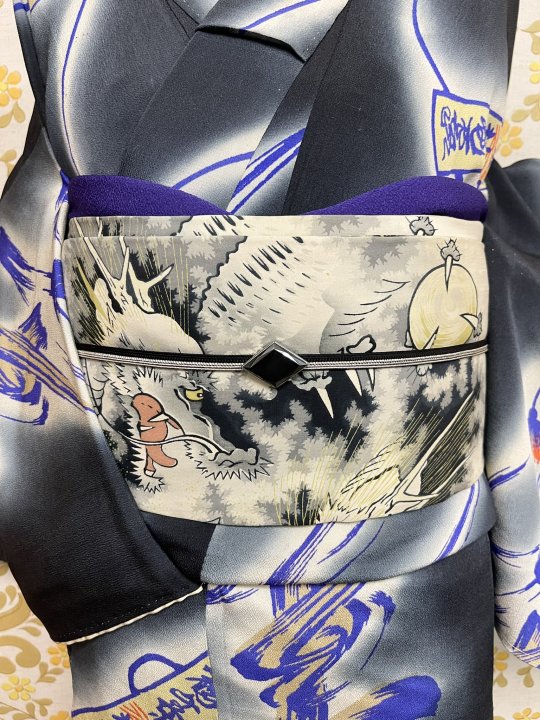

Striking celebratory outfit, pairing a kimono with auspicious kotobuki (long life kanji 寿) and hôkan (lit. "precious scrolls", ie sacred texts rolled into their cases), and powerful dragons nestled among thundery clouds.
#japan#fashion#kimono#obi#dragon#new year#lunar year#chinese zodiac#ryuu#cloud#kumo#kotobuki#auspicious kanji#hokan#houkan#precious scroll#scroll#makimono#着物#帯
166 notes
·
View notes
Text
ety, stolas, and tarakona

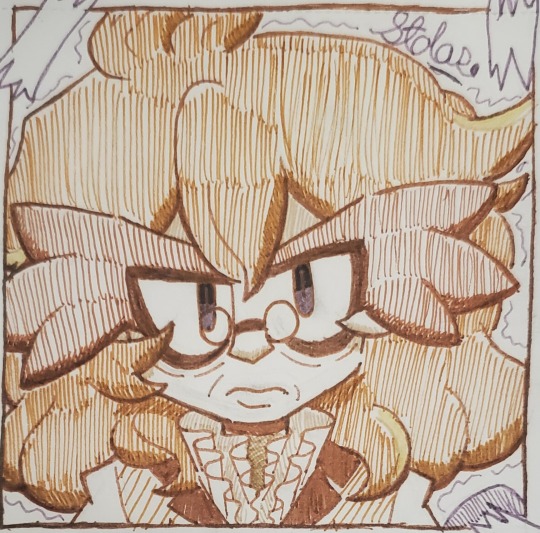

10 notes
·
View notes
Text

#maki is honest & yuta is just soft wish i could see more of their friendship#he has the self esteem of tissue paper#maki is a goat friend tho#anime#jjk#yeah their usernames i just like lol anyone else like makimono sushi?#jujutsu kaisen#anime memes#maki zenin#zenin maki#maki jjk#jjk maki#yuta okkotsu#okkotsu yuta#yutoge
44 notes
·
View notes
Text
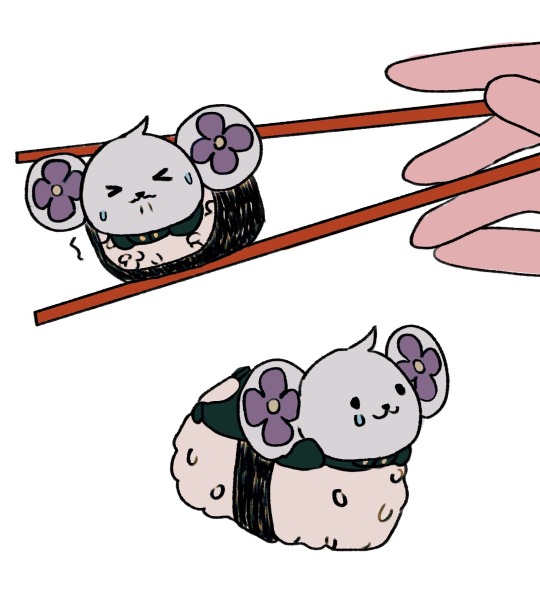
chuunosuke makimono / nigiri
#chuunosuke#naruhodou ryuunosuke#ryuunosuke naruhodou#the great ace attorney chronicles#the great ace attorney#dai gyakuten saiban#tgaa#dgs#aa#ace attorney#matchabunsart#my art#art
204 notes
·
View notes
Text
Tumblr notified me that my Meow sideblog is now four years old. I'm kinda shocked: time drags and flies at the same time, so this kinda snuck up on me, and I've done nothing with it other than save a bunch of cat posts as drafts. Anyway, it got me thinking:
6 notes
·
View notes
Text
When you think it couldn’t go much gayer, Naruto would prove you wrong.

Yeah, Naruto would never remember the whole thing, so I have considered this factor when I come up with this code. How about that?

And himself just proves me right.
Sasuke is truly observant. He has understood both of his teammates to a deeper point. We would guess how our friends might think about certain issues but sometimes we aren’t usually right because we would mix our ideas into them.
Then we could also see Naruto also has a deeper understanding about Sasuke.
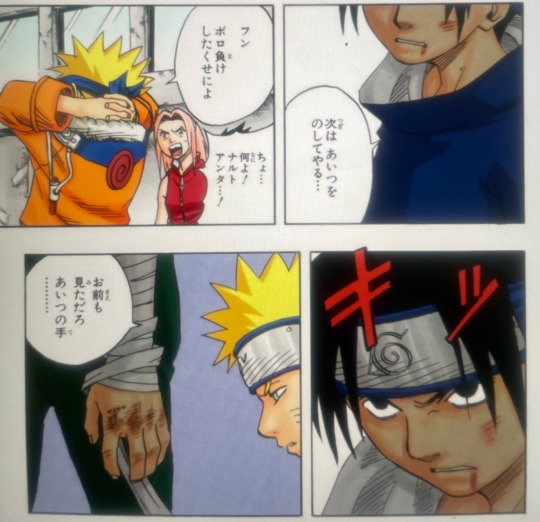
At the beginning, after the fight with Lee, Sasuke is deeply disturbed by the idea that someone close to his age is stronger than him in some ways. He just couldn’t believe it and he is insecure about his strengths, which is rare. Naruto has seen it and known that the way to console him is not cuddle him but tell him what’s truth.

And that’s the answer Sasuke needs to hear.

The second scene is Naruto telling Sasuke off for giving up the makimono to others. Based on his understanding, once Sasuke promises and makes a plan, he is not going to abolish it.
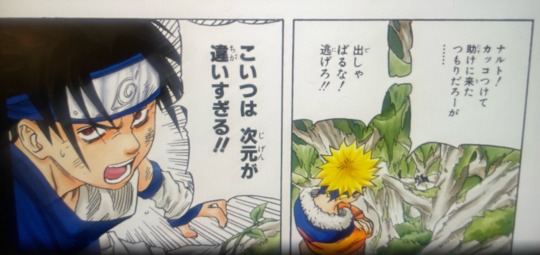
He is truly worried about losing Naruto. It could feel from every panel in this scene. The near-death experience has shaken him to a point that he doesn’t want to lose people and he doesn’t want to die in this test at all.
I am not trying to trash Sakura, but she is more like the third wheel.
14 notes
·
View notes
Note
the other side of the court by makimono is good too!!! but sadly, its not finished (im depressed)
its a love triangle between ushijima, tsukki and reader (karasuno's manager, ex no 1 volleyball player)
omg i definitely saw that before but i didn't read it because i only care for tsukki (i'm sorry) and also the fact that i wholeheartedly cannot make it as a volleyball player let alone be number 1 (my stamina sucks). but since it's recommended, it has piqued my interest and i'll give it a read. watch me skip all the ushijima parts though :D please don't come for me ushijima stans
2 notes
·
View notes
Photo
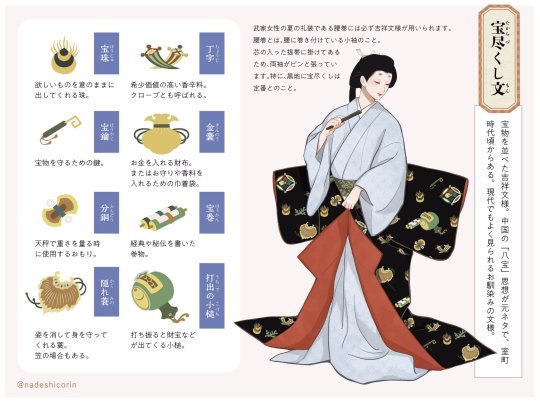
The takarazukushi 宝尽くし or takaramono 宝物 pattern, chart by Nadeshico Rin. This ancient auspicious pattern represents luck-bringing treasures symbols:
Hôju 宝珠, Cintamani flaming jewel said to fulfill wishes
Chôji 丁字, cloves buds, an expensive spice
Hôyaku 宝鑰, granary or warehouse key
Kinnô 金囊, treasure pouch
Fundo 分銅, counterweight
Hôkan 宝巻, scrolls of knowledge (also called more generally makimono)
Kakuremino 隠れ蓑, robe of invisibility (or also hagoromo 羽衣 the heavenly feathered robe)
Uchide no Kozuchi 打ち出の小槌, lucky mallet fulfilling wishes
(List of those fantastical treasures is not set, you can also find other artefacts like: shippô 七宝, geometrical shape representing jewels and precious metal, kakuregasa 隠れ笠, the hat of invisibility, etc).
Rin points that takarazukushi was popular pattern used by samurai women in summer. You can see here how this lady has her katabira 帷子 (summer kimono) around her waist in a way called koshimaki 腰巻. Sleeves stay because they are propped up by a specially reinforced sageobi 提帯 belt.
#japan#fashion#fashion history#Nadeshiko Rin#takarazukushi#Hôju#Chôji#Hôyaku#Kinnô#Fundo#Hôkan#Kakuremino#Uchide no Kozuchi#shippô#kakuregasa#katabira#koshimaki#sageobi#samurai#Muromachi#Edo#着物#帯
338 notes
·
View notes
Text
The Chanoyu Hyaku-shu [茶湯百首], Part II: Poem 27.

〽 Gedai-aru-mono wo yoso ni te miru-toki ha mazu gedai wo ba misete hirake yo
[外題ある物を餘所にて見る時は 先づ外題をば見せて披けよ].
“When something¹ with a gedai [外題] will be inspected somewhere other [than the place where it would usually be displayed²], first [the guests] look at the gedai, and [only] then should it be opened.”

In other words, when something -- be it a kakemono, a (set of) book(s), or a hand-scroll -- is displayed on the floor of the toko, so that the guests may inspect the gedai, they should all naturally look at it where it was placed by the host first, before taking it out of the toko and spreading it out on the mats of the room (so they may inspect its contents carefully).
When the guests are done, if it is a kakemono, then it should be hung up in the toko³, while other objects should be moved to the chigai-dana or dashi fu-zukue, as appropriate.
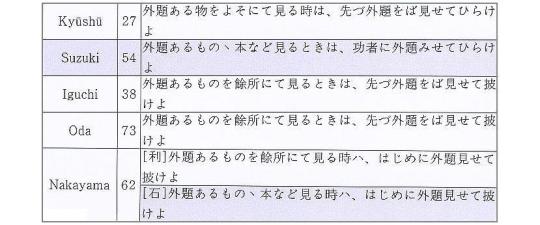
In the case of this poem, we find two variants that are so different that it would be better to treat them as independent, unrelated verses.
The first of these is the version found in the Matsu-ya manuscript:
〽 gedai aru-mono no hon nado miru-toki ha kosha ni gedai misete hirake yo
[外題あるものヽ本など見るときは 功者に外題みせてひらけよ].
“When inspecting something like a book that has a gedai, the most experienced [of the guests], after showing [the others] the gedai, [should] open it [so the others may look at the contents].”

In the early days, much more responsibility was given to the guests than has been the case since the Edo period. When the host displayed an object (whether a scroll, or a set of books) that had a gedai⁴, it was up to the guests to understand how to deal with it. So, the most experienced among their number (who was often not the shōkyaku⁵) should come forward and move the object to the mat in front of the shōkyaku, so that he (and the others⁶) might inspect the gedai closely⁷. Only then would the scroll or book be opened, so that everyone could look at its contents. After they were finished, a kakemono would be hung up, but anything else would be moved to the place where such objects were usually displayed, and left there. (Again, an experienced person would know how to do this, so as to associate the object with its proper kane.)
〽 gedai aru-mono no hon nado miru-toki ha hajime ni gedai misete hirake yo
[外題あるものヽ本など見る時ハ はじめに外題見せて披けよ].
“When showing something like a book that has a gedai, first show the gedai, and then open it.”

This variant appears to have been written during the early Edo period, since it seems to be addressing its remarks to the host. It is found only in the collection of the Hundred Poems that the Sen family was distributing to their disciples during the seventeenth century (and so came into Katagiri Sadamasa’s hands during his youth); and, indeed, it reads like their other instructional materials from that period -- as well as agreeing with their teachings even today.
_________________________
¹Gedai-aru-mono [外題ある物] literally means something that has a gedai affixed to the outside of that object. In the wabi small room setting, this would most likely be the kakemono. But other objects that commonly have gedai are hand-scrolls (e-makimono [繪巻物]) and books* (sho [書] -- below is shown the cover of one of Fujiwara no Sadaie’s Ao-byoshi-hon [青表紙本] editions, showing its gedai) -- and occasionally even things like the large folding fans used by dancers (mai-ōgi [ 舞扇]).

As has been explained before, a gedai is a sort of title card that is attached to the outside of a scroll or other object, indicating the scroll’s contents. It seems that the original gedai were written by the Higashiyama dōbō-shū, when they were inspecting and cataloging the contents of the shōgunal treasure houses. Their gedai usually indicate the name of the artist†, and the title of the work (where this could be deduced‡); and after it was attached, the dōbō impressed his own name-seal overlapping one end of the gedai (and extending onto the backing of the scroll itself), to certify the ascription**. ___________ *Traditional Japanese books were not bound. Rather, a long sheet of paper of the sort that could also be preserved as a hand-scroll, was folded accordion-style, with stiff cardboard end-papers (often covered with the same sort of thin silk that was used for the mountings of kakemono) attached to both ends.
†Not infrequently the name and seals were found to have been lost entirely when damaged sections of the paintings were cut away in earlier times, or when a larger composition was subdivided into several pieces.
‡Not infrequently, a title was included in the colophon that the artist wrote down the left (or, less commonly, right) side of the painting. When this was not the case, some other means would be used to name the painting (for example, simply stating that it was a painting of Shakyamuni, or the Bodhisattva Kannon draped in a white robe). The individual scenes from the Xiāo-Xiāng bā-jǐng [瀟湘八景] (Eight Scenes of the Xiāo-Xiāng Watershed), for example, all had titles that had been standardized for centuries (so all the person reviewing the painting had to do was identify the salient elements -- such as a temple’s bell-tower or several sailboats approaching harbor -- in order to match the picture with its title).
When a title was not obvious, none was provided, and the gedai only gave the adduced name of the artist.
**When the dōbō-shū arrived in Japan, following the collapse of the Goryeo government, the Ashikaga shōgunal warehouses contained countless scrolls of varying quality, that had been received as gifts (or tribute) from various entities around the country. Some were obviously Japanese forgeries, while others were of dubious merit, and still others were without any identifying annotations whatsoever. The first job given to the dōbō-shū (who seem to have applied to the shōgun’s court for employment) was to review and certify the quality of every piece in the collection -- while preserving those worthy of conservation by mounting or remounting some as hanging scrolls, preparing others as e-makimono, and using still others for papering the walls and sliding doors of cupboards and the like in the shōgun’s personal residence -- while the forgeries and inferior pieces were eliminated. This is why the earliest pieces often feature a small square seal reading Dōu [道有], which was the name taken by the third Ashikaga shōgun Yoshimitsu after he became nyūdō in 1395, since his post-retirement court appears to have been the first court to employ the dōbō-shū. The Xiāo-Xiāng bā-jǐng [瀟湘八景] by Mùqī Fǎ-cháng [牧谿法常; 1210?–1269?] were among the first works of art to be certified at that time.
²While the other versions of this poem specifically mention a book or set of books (hon [本]), the Kyūshū manuscript version (and a majority of the others) does not. Kakemono were traditionally hung up in the toko, books were displayed on the chigai-dana, and hand-scrolls were most often placed out on the dashi fu-zukue [出文机] (the built-in writing desk often called the tsuke-shoin [付書院] today.
Here, however, the implication is that these things would be placed on the floor of the toko -- to display their gedai* -- and only after the guests have inspected the gedai (in situ), would the object be taken out and opened on the floor of the tea room (so the guests could examine its contents closely)...before it was moved to its “usual place” (hung up on the wall, or placed on the chigai-dana or dashi fu-zukue) and displayed there for at least the rest of the shoza. ___________ *This practice is called gedai-kazari [外題飾].
³Usually the host comes out when he hears the guests quiet down and answers their questions about the gedai. Then he takes the scroll out of the toko and, after they look at the gedai carefully there (usually the host holds it up for them to look at closely), he opens it on the mats so they may inspect its contents.
When they are done, the host should place the object where it would usually be displayed -- hanging on the back wall of the toko, or arranged on the chigai-dana or dashi fu-zukue, as appropriate.
While it has been considered to be responsibility of the host to attend to these things since the Edo period (indeed, many of the modern schools have prescribed formulae for doing this), in Jōō’s and Rikyū’s day, the guests frequently attended to these things themselves (while the host was occupied with his last-minute preparations). This situation is addressed in Jōō’s original version of this poem.
⁴While a kakemono would have to be displayed on the floor of the toko for the guests to understand that it had a gedai, the other objects would be displayed in their usual places -- on the chigai-dana or on the dashi fu-zukue -- closed and with the gedai facing upward as they always are, so that the guests could look at them in due course.
⁵If the shōkyaku does not have much experience of chanoyu, then the host should invite a very experienced person to be the second guest, so that this person may assist the shōkyaku whenever necessary.
⁶Objects of this sort were not usually passed around*. The scroll or book(s) would be placed on the mat in front of the shōkyaku, and the other guests would move from their places and circle around the object, so they might look at it also. The object would then be opened out on the mat, so that the shōkyaku would have the best view, after which it would be either hung up in the toko, or placed on the chigai-dana or dashi fu-zukue. ___________ *When Jōō writes about a gedai, he is referring to one attached to the scroll or book by one of the Higashiyama dōbō-shū, and prepared for Yoshimasa. These objects were extremely precious, and extremely fragile. So it was important to handle them as little as possible.
⁷If the gedai was written by one of the dōbō-shū, then the guests should take note of the seal in order to ascertain which of them certified the scroll as being authentic.
==============================================
◎ If these translations are valuable to you, please consider donating to support this work. Donations from the readers are the only source of income for the translator. Please use the following link:
https://PayPal.Me/chanoyutowa
2 notes
·
View notes
Note
Very curious about 11👀, also 13 and 32?
Thanks for the ask!! <3 <3
11. I read some stories from Japanese mythology that were pretty nice and that I'd otherwise not have encountered (I'm not huge on mythology, in general). I love chimeras and things of this sort, so the descriptions of the Kappa were fun to read. Also, it's neat that the makimono roll is named after the mythological creature.
EDIT: I forgot a part of the question. Sorry!
Research is the best part of writing. Everything can become a special interest or a hobby if you write weird stuff :) So I don't really worry. I just do it to my heart's content hehe
13. I didn't think I'd enjoy writing fluff? I love angst in any medium, so I was very pleasantly surprised to enjoy planning silly fluffy scenes for your prompts. I haven't gotten to write the properly fluffy scenes yet, but I'm very excited. I'm going through 20 articles about etiquette to have Atuat intentionally annoy/embarrass Hei-Ran in any way that she likes LMFAO
32. I don't think so? I enjoy writing in 3rd proximate, so my writing definitely changes according to the pov I'm writing. But I really hope that's not too jarring. Somebody else would have to tell me. What do you think?
3 notes
·
View notes
Text
0 notes
Text
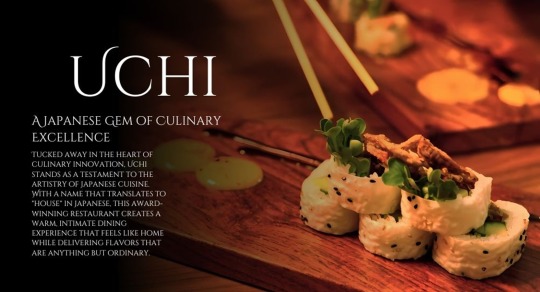
Uchi: A Japanese Gem of Culinary Excellence
Tucked away in the heart of culinary innovation, Uchi stands as a testament to the artistry of Japanese cuisine. With a name that translates to "house" in Japanese, this award-winning restaurant creates a warm, intimate dining experience that feels like home while delivering flavors that are anything but ordinary.
Uchi’s menu seamlessly blends traditional Japanese techniques with bold, modern interpretations. From exquisitely fresh sashimi to inventive makimono rolls, every dish is a work of art. Signature offerings like the Hama Chili, a delicate combination of yellowtail, Thai chili, and ponzu, and the Hot Rock Wagyu, where diners sear premium beef on a sizzling stone, showcase the restaurant's knack for elevating simplicity into the extraordinary.
0 notes
Text

TOM FORD Beauty and CARTIER converge on one of SASHA GYMN's makimono
0 notes
Text
Why would Germans know how to make good Mexican food? It is all about immigration on proximity. Neither of which are active in this case. Germany has just started to have salsa and flour tortillas in the past few years.
Switzerland doesn't even have many Greek restaurants, and Greece is nearby in comparison to Mexico. In fact, I found more Greek food in Australia.
Also they put mayo in Makimono rolls. Why? I don't know, but it is very sad for my mouth.

These carne asada tacos from Germany....
35K notes
·
View notes
Text
Japanese food 🍱 time

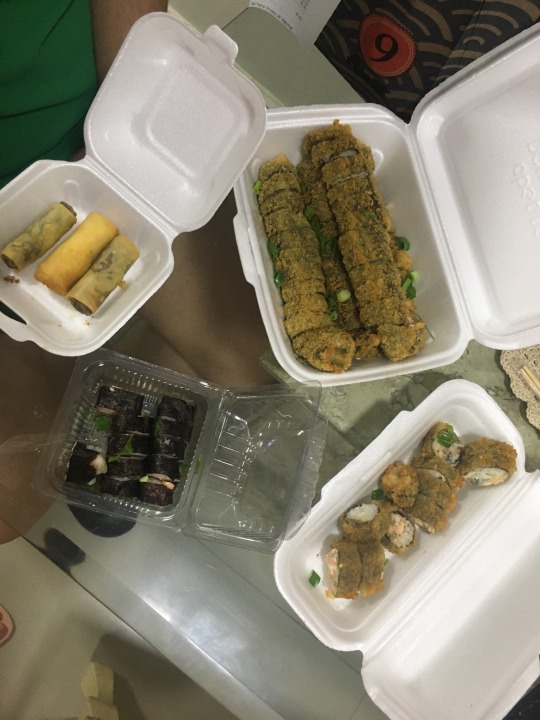
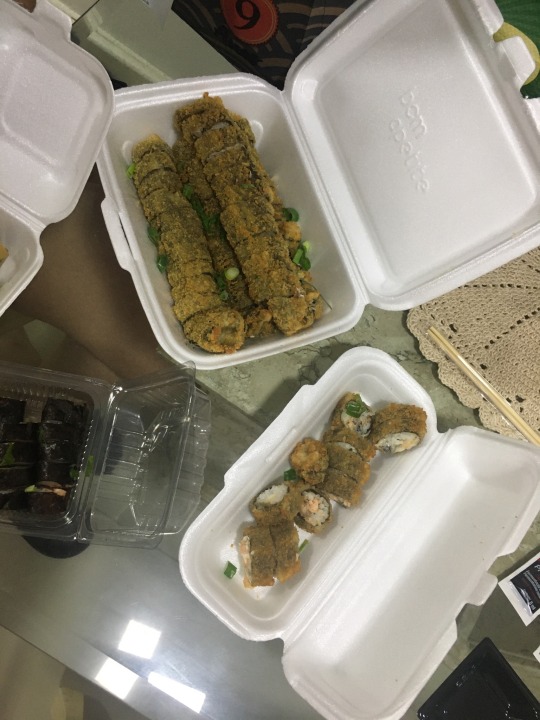
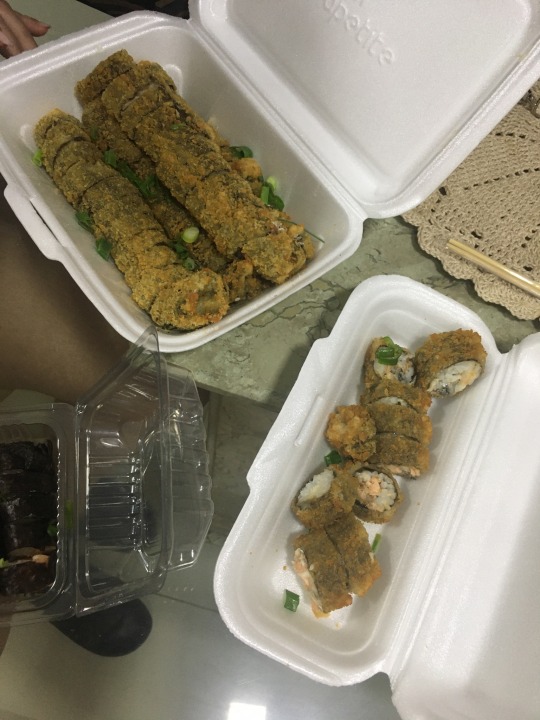
Shrimp 🦐 makimono
Hot rolls salmon tuna and shrimp

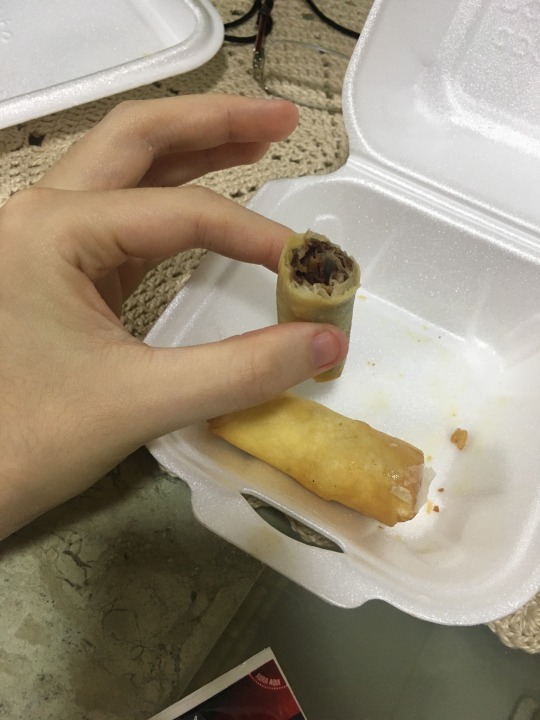


This white chocolate harumaki was paradise to eat
The milk chocolate wasn’t mine just took the picture to show inside
Very pretty
0 notes